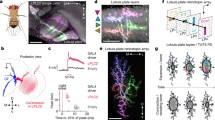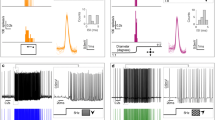Abstract
Neurons in the locust visual system encode approaches of looming stimuli and are implicated in production of escape behaviours. The lobula giant movement detector (LGMD) and its postsynaptic partner, the descending contralateral movement detector (DCMD) compute characteristics of expanding edges across the locust eye during a loom and DCMD synapses onto motor elements associated with behaviour. We identified another descending interneuron within the locust ventral nerve cord. We named this neuron the late DCMD (LDCMD) as it responds later during an approach, with the firing rate peaking at about the time of collision. LDCMD produced lower amplitude, broader action potentials that were associated with an afterhyperpolarization, whereas DCMD action potentials showed a brief afterhyperpolarization often followed by an afterdepolarization. Within the mesothoracic ganglion, the primary LDCMD axon located adjacent to the DCMD axon, was thinner and lacked collateral projections to the lateral region of the neuropil. When compared with DCMD, LDCMD fired with fewer spikes during a loom and showed weaker habituation to repeated approaches. Coincidence of LDCMD and DCMD firing increased during object approach. Our findings indicate the presence of an additional motion-sensitive descending neuron in the locust that encodes temporally distinct properties of an approaching object.








Similar content being viewed by others
References
Aertsen AM, Gerstein GL, Habib MK, Palm G (1989) Dynamics of neuronal firing correlation: Modulation of “Effective connectivity”. J Neurophysiol 61:900–917
Burrows M (1996) The neurobiology of an insect brain. Oxford University Press, Oxford
Burrows M, Rowell CHF (1973) Connections between descending visual interneurons and metathoracic motoneurons in the locust. J Comp Physiol A 85:221–234
Cao P, Gu Y, Wang SR (2004) Visual neurons in the pigeon brain encode the acceleration of stimulus motion. J Neurosci 24:7690–7698
Catton WT (1980) Tonic effects of stationary luminous slits on the discharge rates of some locust visual interneurones. J Insect Physiol 26:373–379
Catton WT (1982) The effects of stimulus area and intensity on the on/off ratio of some locust visual interneurones. J Insect Physiol 28:285–291
Catton WT (1988) Discharge patterns of locust visual interneurones. Physiol Entomol 13:147–152
Ellard CG (2004) Visually guided locomotion in the gerbil: a comparison of open- and closed-loop control. Behav Brain Res 149:41–48
Fotowat H, Gabbiani F (2007) Relationship between the phases of sensory and motor activity during a looming-evoked multistage escape behavior. J Neurosci 27:10047–10059
Gabbiani F, Krapp HG, Laurent G (1999) Computation of object approach by a wide-field motion-sensitive neuron. J Neurosci 19:1122–1141
Gabbiani F, Krapp HG, Koch C, Laurent G (2002) Multiplicative computation in a visual neuron sensitive to looming. Nature 420:320–324
Gabbiani F, Cohen I, Laurent G (2005) Time-dependent activation of feed-forward inhibition in a looming-sensitive neuron. J Neurophysiol 94:2150–2161
Gallagher SP, Northmore DPM (2006) Responses of the teleostean nucleus isthmi to looming objects and other moving stimuli. Vis Neurosci 23:209–219
Gray JR (2005) Habituated visual neurons in locusts remain sensitive to novel looming objects. J Exp Biol 208:2515–2532
Gray R, Regan DM (2006) Unconfounding the direction of motion in depth, time to passage and rotation rate of an approaching object. Vis Res 46:2388–2402
Gray JR, Lee JK, Robertson RM (2001) Activity of descending contralateral movement detector neurons and collision avoidance behaviour in response to head-on visual stimuli in locusts. J Comp Physiol A 187:115–129
Griss C, Rowell CHF (1986) Three descending interneurons reporting deviation from course in the locust. I. Anatomy. J Comp Physiol A 158:765–774
Guest BB, Gray JR (2006) Responses of a looming-sensitive neuron to compound and paired object approaches. J Neurophysiol 95:1428–1441
Hatsopoulos N, Gabbiani F, Laurent G (1995) Elementary computation of object approach by a wide-field visual neuron. Science 270:1000–1003
Horridge GA (1978) The separation of visual axes in apposition compound eyes. Phil Trans R Soc (Lond) B 285:1–59
Jablonski PG, Strausfeld NJ (2001) Exploitation of an ancient escape circuit by an avian predator: relationships between taxon-specific prey escape circuits and the sensitivity to visual cues from the predator. Brain Behav Evol 58:218–240
Krapp HG, Gabbiani F (2005) Spatial distribution of inputs and local receptive field properties of a wide-field, looming sensitive neuron. J Neurophysiol 93:2240–2253
Maier JX, Neuhoff JG, Logothetis NK, Ghazanfar AA (2004) Multisensory integration of looming signals by rhesus monkeys. Neuron 43:177–181
Matheson T, Rogers SM, Krapp HG (2004) Plasticity in the visual system is correlated with a change in lifestyle of solitarious and gregarious locusts. J Neurophysiol 91:1–12
Miall RC (1978) The flicker fusion frequencies of six laboratory insects, and the response of the compound eye to mains fluorescent ‘ripple’. Physiol Entomol 3:99–106
Money T, DeCarlo C, Robertson R (2006) Temperature-sensitive gating in a descending visual interneuron, DCMD. J Comp Physiol A 192:915–925
Oliva D, Medan V, Tomsic D (2007) Escape behavior and neuronal responses to looming stimuli in the crab Chasmagnathus granulatus (decapoda: Grapsidae). J Exp Biol 210:865–880
Ostojic S, Brunel N, Hakim V (2009) How connectivity, background activity, and synaptic properties shape the cross-correlation between spike trains. J Neurosci 29:10234–10253
Pearson KG, O’Shea M (1984) Escape behavior of the locust. The jump and its initiation by visual stimuli. In: Eaton RC (ed) Neural mechanisms of startle behavior. Plenum Press, New York, pp 163–178
Poljac E, Neggers B, Berg AV (2006) Collision judgment of objects approaching the head. Exp Brain Res 171:35–46
Preuss T, Osei-Bonsu PE, Weiss SA, Wang C, Faber DS (2006) Neural representation of object approach in a decision-making motor circuit. J Neurosci 26:3454–3464
Rind FC (1984) A chemical synapse between two motion detecting neurones in the locust brain. J Exp Biol 110:143–167
Rind FC (1987) Non-directional, movement sensitive neurones of the locust optic lobe. J Comp Physiol A 161:477–494
Rind FC, Bramwell DI (1996) Neural network based on the input organization of an identified neuron signaling impending collision. J Neurophysiol 75:967–985
Rind FC, Simmons PJ (1997) Signaling of object approach by the DCMD neuron of the locust. J Neurophysiol 77:1029–1033
Robertson RM, Johnson AG (1993) Collision avoidance of flying locusts: Steering torques and behaviour. J Exp Biol 183:35–60
Robertson RM, Pearson KG (1982) A preparation for the intracellular analysis of neuronal activity during flight in the locust. J Comp Physiol A 146:311–320
Robertson RM, Pearson KG (1983) Interneurons in the flight system of the locust: distribution, connections and resetting properties. J Comp Neurol 215:33–50
Robertson RM, Reye DN (1992) Wing movements associated with collision-avoidance manoeuvers during flight in the locust, Locusta migratoria. J Exp Biol 163:231–258
Rogers SM, Krapp HG, Burrows M, Matheson T (2007) Compensatory plasticity at an identified synapse tunes a visuomotor pathway. J Neurosci 27:4621–4633
Rowell CHF, Pearson KG (1983) Ocellar input to the flight motor system of the locust: structure and function. J Exp Biol 103:265–288
Rowell CHF, Reichert H (1986) Three descending interneurons reporting deviation from course in the locust. II. Physiology. J Comp Physiol A 158:775–794
Santer RD, Simmons PJ, Rind FC (2005) Gliding behaviour elicited by lateral looming stimuli in flying locusts. J Comp Physiol A 191:61–73
Santer RD, Rind FC, Stafford R, Simmons PJ (2006) Role of an identified looming-sensitive neuron in triggering a flying locust’s escape. J Neurophysiol 95:3391–3400
Schlotterer GR (1977) Response of the locust descending movement detector neuron to rapidly approaching and withdrawing visual stimuli. Can J Zool 55:1372–1376
Simmons PJ (1980) Connexions between a movement-detecting visual interneurone and flight motoneurones of a locust. J Exp Biol 86:87–97
Simmons PJ, Rind FC (1997) Responses to object approach by a wide field visual neurone, the LGMD2 of the locust: characterization and image cues. J Comp Physiol A 180:203–214
Smith MA, Kohn A (2008) Spatial and temporal scales of neuronal correlation in primary visual cortex. J Neurosci 28:12591–12603
Sun H, Frost BJ (1998) Computation of different optical variables of looming objects in pigeon nucleus rotundus neurons. Nat Neurosci 1:296–303
Vallis LA, McFadyen BJ (2003) Locomotor adjustments for circumvention of an abstacle in the travel path. Exp Brain Res 152:409–414
Vallis L, McFadyen B (2005) Children use different anticipatory control strategies than adults to circumvent an obstacle in the travel path. Exp Brain Res 167:119–127
Verspui R, Gray JR (2009) Visual stimuli induced by self-motion and object-motion modify odour-guided flight of male moths (Manduca sexta l.). J Exp Biol 212:3272–3282
Waloff Z (1972) Orientation of flying locusts, Schistocerca gregaria (forsk.), in migrating swarms. Bull Ent Res 62:1–72
Yamamoto K, Nakata M, Nakagawa H (2003) Input and output characteristics of collision avoidance behavior in the frog Rana catesbeiana. Brain BehavEvol 62:201–211
Yamawaki Y, Toh Y (2009) Responses of descending neurons to looming stimuli in the praying mantis Tenodera aridifolia. J Comp Physiol A 195:253–264
Acknowledgments
We thank T. G. A. Money for providing valuable comments on an earlier version of the manuscript. This work was supported by grants from the Natural Science and Engineering Research Council of Canada (NSERC) to J. R. Gray and R. M. Robertson as well as a University of Saskatchewan Graduate Teaching Fellowship to E. Blincow.
Author information
Authors and Affiliations
Corresponding author
Electronic supplementary material
Below is the link to the electronic supplementary material.
359_2010_576_MOESM1_ESM.pdf
Quantification of neuronal firing parameters. A sample peristimulus time histogram of the DCMD response to a looming disc aligned to time of projected collision (TTC = 0 s). The firing parameters measured were the maximum firing rate (dashed line), the time of peak firing (*), the width of the response profile at ½ maximal firing (dotted line), the firing rate 200 ms before collision and the number of spikes
359_2010_576_MOESM2_ESM.pdf
Habituation of LDCMD and DCMD response profiles from a single representative locust. Each plot is a Gaussian smoothed (50 ms bin width) peristimulus time histogram of a response to a single approach within a consecutive series of twenty approaches (from top to bottom, respectively). In this example the DCMD habituated quickly and stopped responding after the tenth approach whereas the LDCMD habituated within the first three approaches but continued to respond throughout the series. Data were aligned to TOC (red vertical line)
359_2010_576_MOESM3_ESM.pdf
Relative habituation of LDCMD and DCMD firing parameters. Data from the final approach in a series of 8 to 50 approaches were normalized to the value in response to the first approach. Larger values indicate weaker habituation. LDCMD habituated less with respect to all parameters measured. Parametric data in a and b (bar charts) were compared with a student’s t-test whereas non parametric data in c and d (box plots) were compared with a Mann–Whitney rank sum test. Error bars in a and b represent standard deviation. Boxes in c and d indicate interquartile range and median value, whiskers indicate the 5 and 95% confidence levels and dots indicate range. Different letters above each bar or box indicate significant differences. n = 8 locusts
359_2010_576_MOESM4_ESM.pdf
Power spectral densities of LDCMD (red) and DCMD (black) firing during presentation of looming stimuli. A prominent peak at 65 Hz in the DCMD spectrum (arrow) is absent from the LDCMD spectrum. Spectra were normalized such that the sum of all spectra for each neuron was set to 100. Data were selected from 70 single approaches to 29 locusts
359_2010_576_MOESM5_ESM.pdf
Assessment of the significance of the JSPTH matrix bin counts. The bin counts are represented as the logarithm of the derived probability of a binary representation within each bin. Coincidence was assumed to be binary (1 or 0) where bins based on random firing would not have a value greater than 1. The actual bin counts, represented by the colour scale, clearly show many values > 1, strongly indicating that coincidence firing in those bins was not due to chance
Rights and permissions
About this article
Cite this article
Gray, J.R., Blincow, E. & Robertson, R.M. A pair of motion-sensitive neurons in the locust encode approaches of a looming object. J Comp Physiol A 196, 927–938 (2010). https://doi.org/10.1007/s00359-010-0576-7
Received:
Revised:
Accepted:
Published:
Issue Date:
DOI: https://doi.org/10.1007/s00359-010-0576-7




